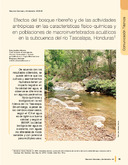| dc.contributor.author | García, Lina Andrea | es_ES |
| dc.contributor.author | Jiménez Otárola, Francisco | es_ES |
| dc.date.accessioned | 2015-03-19T21:22:47Z | |
| dc.date.available | 2015-03-19T21:22:47Z | |
| dc.date.issued | 2006-08 | |
| dc.identifier | 470476 | es_ES |
| dc.identifier.issn | e-ISSN: 1659-1216 | es_ES |
| dc.identifier.uri | https://repositorio.catie.ac.cr/handle/11554/6130 | |
| dc.description | 14 páginas, 4 figuras, 6 tabulaciones, 30 referencias. | es_ES |
| dc.description.abstract | Se efectuó una caracterización del estado físicoquímico, geomorfológico y biológico en la red hídrica de la subcuenca del río Tascalapa, Honduras. Los datos fueron colectados en doce estaciones agrupadas en dos escenarios: cuatro estaciones con bosque y ocho estaciones con actividades agropecuarias y viviendas. Las variables biofísicas evaluadas fueron: estado de conservación de la vegetación ribereña, conservación del cauce y riqueza de hábitat en las fuentes. Los parámetros físico-químicos evaluados fueron: oxígeno disuelto (mg/l), sólidos totales disueltos (mg/l), conductividad (mS/cm), temperatura (°C), turbidez (UTN), nitratos (mg/l), ortofosfatos, pH y coliformes fecales (UFC). Las variables biológicas analizadas fueron valores de abundancia correspondiente a cada uno de los grupos de macroinvertebrados. Los resultados mostraron que los cultivos y asentamientos humanos tienen un impacto negativo en algunos parámetros físico-químicos y biológicos en la red hídrica entre ellos, los coliformes fecales, el pH y la turbiedad. La interrelación observada entre el índice de uso de la tierra, la calidad física del cauce, el índice físico-químico de calidad del agua y los índices bióticos muestran que los macroinvetebrados son buenos predictores del estado de calidad del agua de las fuentes y pueden ser empleados como herramienta para medir los impactos de la adopción de tecnologías de conservación y restauración de cuencas. | es_ES |
| dc.description.abstract | The physical, chemical, geomorphological, and biological conditions were characterized in 12 sampling stations located in the Tascalapa river subwatershed, Honduras. Sampling stations were grouped into two treatments: four stations were dominated by forest and eight stations by agriculture and human settlements. The variables measured at each sampling station for the physical characterization were: the state of conservation of riparian vegetation, conservation of the channel, and habitat richness at source. The physic-chemical parameters measured were: dissolved oxygen (mg/l), total dissolved solids (mg/l), conductivity (mS/cm), temperature (°C), pH, turbidity (NTU), nitrates (mg/l), orthophosphates (mg/l), and fecal bacteria (UFC/ml). With regard to the biological variables, the abundance of each group of macroinvertebrates was determined. Results showed that crops and human settlements have a negative impact on some physic-chemical and biological parameters among them: fecal bacteria, turbidity and pH. Interrelationships among the land use index, the physical quality of the channel, the water quality index, and biotic indices show that the macroinvertebrates are good indicators of water quality at source, and therefore could be used as an effective tool to evaluate the impacts of implementing measures for the conservation and restoration of watersheds. | |
| dc.language.iso | es | es_ES |
| dc.publisher | CATIE, Turrialba (Costa Rica) | es_ES |
| dc.relation.ispartof | Recursos Naturales y Ambiente Número 48 (2006 Agosto), páginas 35-46 | |
| dc.rights | info:eu-repo/semantics/openAccess | |
| dc.subject | BOSQUES | es_ES |
| dc.subject | ZONAS RIPICOLAS | es_ES |
| dc.subject | CUENCAS HIDROGRAFICAS | es_ES |
| dc.subject | CALIDAD DEL AGUA | es_ES |
| dc.subject | POLUCION DEL AGUA | es_ES |
| dc.subject | PROPIEDADES FISICOQUIMICAS | es_ES |
| dc.subject | ORGANISMOS INDICADORES | es_ES |
| dc.subject | HIONDURAS | es_ES |
| dc.title | Efectos del bosque ribereño y de las actividades antrópicas en las características físico-químicas y en poblaciones de macroinvertebrados acuáticos en la subcuenca del río Tascalapa, Honduras | es_ES |
| dc.title.alternative | Effect of riparian forest and of anthropic activities in both physic-chemical characteristics and benthic macroinvertebrate populations in the Tascalapa river sub-watershed, Honduras | es_ES |
| dc.type | Artículo | es_ES |


